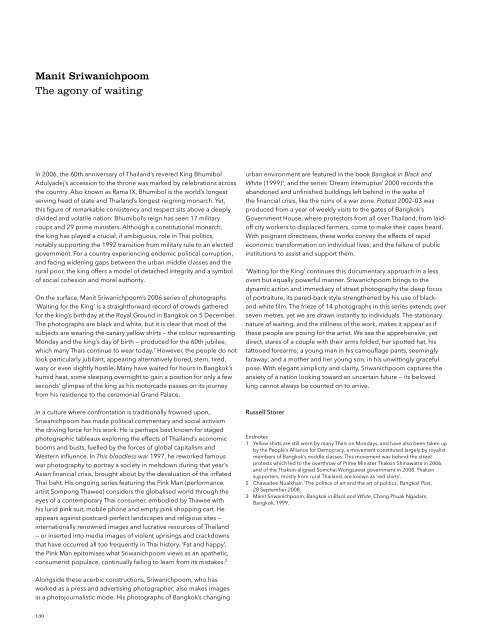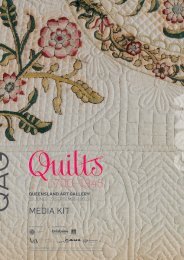Queensland Art Gallery - Queensland Government
Queensland Art Gallery - Queensland Government
Queensland Art Gallery - Queensland Government
Create successful ePaper yourself
Turn your PDF publications into a flip-book with our unique Google optimized e-Paper software.
Manit Sriwanichpoom<br />
The agony of waiting<br />
In 2006, the 60th anniversary of Thailand’s revered King Bhumibol<br />
Adulyadej’s accession to the throne was marked by celebrations across<br />
the country. Also known as Rama IX, Bhumibol is the world’s longest<br />
serving head of state and Thailand’s longest reigning monarch. Yet,<br />
this figure of remarkable consistency and respect sits above a deeply<br />
divided and volatile nation: Bhumibol’s reign has seen 17 military<br />
coups and 29 prime ministers. Although a constitutional monarch,<br />
the king has played a crucial, if ambiguous, role in Thai politics,<br />
notably supporting the 1992 transition from military rule to an elected<br />
government. For a country experiencing endemic political corruption,<br />
and facing widening gaps between the urban middle classes and the<br />
rural poor, the king offers a model of detached integrity and a symbol<br />
of social cohesion and moral authority.<br />
On the surface, Manit Sriwanichpoom’s 2006 series of photographs<br />
‘Waiting for the King’ is a straightforward record of crowds gathered<br />
for the king’s birthday at the Royal Ground in Bangkok on 5 December.<br />
The photographs are black and white, but it is clear that most of the<br />
subjects are wearing the canary yellow shirts — the colour representing<br />
Monday and the king’s day of birth — produced for the 60th jubilee,<br />
which many Thais continue to wear today. 1 However, the people do not<br />
look particularly jubilant, appearing alternatively bored, stern, tired,<br />
wary or even slightly hostile. Many have waited for hours in Bangkok’s<br />
humid heat, some sleeping overnight to gain a position for only a few<br />
seconds’ glimpse of the king as his motorcade passes on its journey<br />
from his residence to the ceremonial Grand Palace.<br />
urban environment are featured in the book Bangkok in Black and<br />
White (1999) 3 , and the series ‘Dream interruptus’ 2000 records the<br />
abandoned and unfinished buildings left behind in the wake of<br />
the financial crisis, like the ruins of a war zone. Protest 2002–03 was<br />
produced from a year of weekly visits to the gates of Bangkok’s<br />
<strong>Government</strong> House, where protestors from all over Thailand, from laidoff<br />
city workers to displaced farmers, come to make their cases heard.<br />
With poignant directness, these works convey the effects of rapid<br />
economic transformation on individual lives, and the failure of public<br />
institutions to assist and support them.<br />
‘Waiting for the King’ continues this documentary approach in a less<br />
overt but equally powerful manner. Sriwanichpoom brings to the<br />
dynamic action and immediacy of street photography the deep focus<br />
of portraiture, its pared-back style strengthened by his use of blackand-white<br />
film. The frieze of 14 photographs in this series extends over<br />
seven metres, yet we are drawn instantly to individuals. The stationary<br />
nature of waiting, and the stillness of the work, makes it appear as if<br />
these people are posing for the artist. We see the apprehensive, yet<br />
direct, stares of a couple with their arms folded, her spotted hat, his<br />
tattooed forearms; a young man in his camouflage pants, seemingly<br />
faraway; and a mother and her young son, in his unwittingly graceful<br />
pose. With elegant simplicity and clarity, Sriwanichpoom captures the<br />
anxiety of a nation looking toward an uncertain future — its beloved<br />
king cannot always be counted on to arrive.<br />
In a culture where confrontation is traditionally frowned upon,<br />
Sriwanichpoom has made political commentary and social activism<br />
the driving force for his work. He is perhaps best known for staged<br />
photographic tableaux exploring the effects of Thailand’s economic<br />
booms and busts, fuelled by the forces of global capitalism and<br />
Western influence. In This bloodless war 1997, he reworked famous<br />
war photography to portray a society in meltdown during that year’s<br />
Asian financial crisis, brought about by the devaluation of the inflated<br />
Thai baht. His ongoing series featuring the Pink Man (performance<br />
artist Sompong Thawee) considers the globalised world through the<br />
eyes of a contemporary Thai consumer, embodied by Thawee with<br />
his lurid pink suit, mobile phone and empty pink shopping cart. He<br />
appears against postcard-perfect landscapes and religious sites —<br />
internationally renowned images and lucrative resources of Thailand<br />
— or inserted into media images of violent uprisings and crackdowns<br />
that have occurred all too frequently in Thai history. ‘Fat and happy’,<br />
the Pink Man epitomises what Sriwanichpoom views as an apathetic,<br />
consumerist populace, continually failing to learn from its mistakes. 2<br />
Alongside these acerbic constructions, Sriwanichpoom, who has<br />
worked as a press and advertising photographer, also makes images<br />
in a photojournalistic mode. His photographs of Bangkok’s changing<br />
Russell Storer<br />
Endnotes<br />
1 Yellow shirts are still worn by many Thais on Mondays, and have also been taken up<br />
by the People’s Alliance for Democracy, a movement constituted largely by royalist<br />
members of Bangkok’s middle classes. This movement was behind the street<br />
protests which led to the overthrow of Prime Minister Thaksin Shinawatra in 2006,<br />
and of the Thaksin-aligned Somchai Wongsawat government in 2008. Thaksin<br />
supporters, mostly from rural Thailand, are known as ‘red shirts’.<br />
2 Chawadee Nualkhair, ‘The politics of art and the art of politics’, Bangkok Post,<br />
28 September 2008.<br />
3 Manit Sriwanichpoom, Bangkok in Black and White, Chang Phuak Ngadam,<br />
Bangkok, 1999.<br />
Manit Sriwanichpoom<br />
Thailand b.1961<br />
‘Waiting for the King (standing)’ series 2006<br />
Gelatin silver print, ed. 1/9 / 50 x 49.5cm / Purchased 2008<br />
with funds derived from the Bequest of Grace Davies<br />
and Nell Davies through the <strong>Queensland</strong> <strong>Art</strong> <strong>Gallery</strong><br />
Foundation / Collection: <strong>Queensland</strong> <strong>Art</strong> <strong>Gallery</strong><br />
130 131
















